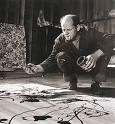Paul Jackson Pollock 1912 – 1956
December 16, 2008
 Paul Jackson
Pollock 1912 – 1956 was
an influential American painter and a major force in the abstract
expressionist movement. He was married to noted abstract painter Lee
Krasner.
Paul Jackson
Pollock 1912 – 1956 was
an influential American painter and a major force in the abstract
expressionist movement. He was married to noted abstract painter Lee
Krasner.
Lee Krasner suggested that Jackson Pollock see a homeopath for his depression and alcohol problem, and so Jackson Pollock consulted homeopath Elizabeth Wright Hubbard. Elizabeth Wright Hubbard had been Lee Krasner’s homeopath for many years.
In October 1945, Pollock married another important American painter, Lee Krasner, and in November they moved to what is now known as the Pollock Krasner House and Studio in Springs on Long Island, New York. Peggy Guggenheim loaned them the down payment for the wood frame house with a nearby barn that Pollock made into a studio. It was there that he perfected the technique of working spontaneously with liquid paint.
Pollock was introduced to the use of liquid paint in 1936, at an experimental workshop operated in New York City by the Mexican muralist David Alfaro Siqueiros.
He later used paint pouring as one of several techniques in canvases of the early 1940s, such as “Male and Female” and “Composition with Pouring I.”
After his move to Springs, he began painting with his canvases laid out on the studio floor, and developed what was later called his “drip” technique. The drip technique required paint with a fluid viscosity so Pollock turned to then new synthetic resin based paints, called alkyd enamels. Pollock described this use of household paints, instead of artist’s paints, as “a natural growth out of a need”.
He used hardened brushes, sticks and even basting syringes as paint applicators. Pollock’s technique of pouring and dripping paint is thought to be one of the origins of the term action painting. With this technique, Pollock was able to achieve a more immediate means of creating art, the paint now literally flowing from his chosen tool onto the canvas.
By defying the conventional way of painting on an upright surface, he added a new dimension, literally, by being able to view and apply paint to his canvases from all directions.
In the process of making paintings in this way he moved away from figurative representation, and challenged the Western tradition of using easel and brush, as well as moving away from use only of the hand and wrist; as he used his whole body to paint… Pollock’s most famous paintings were during the “drip period” between 1947 and 1950. He rocketed to popular status following an August 8, 1949 four page spread in Life Magazine that asked, “Is he the greatest living painter in the United States?” At the peak of his fame, Pollock abruptly abandoned the drip style.
Pollock’s work after 1951 was darker in color, including a collection in black on unprimed canvases, followed by a return to color and he reintroduced figurative elements. During this period Pollock had moved to a more commercial gallery and there was great demand from collectors for new paintings. In response to this pressure, along with personal frustration, his alcoholism deepened…
Pollock wanted an end to the viewer’s search for representational elements in his paintings, thus he abandoned naming them and started numbering them instead.
Of this, Pollock commented: “…look passively and try to receive what the painting has to offer and not bring a subject matter or preconceived idea of what they are to be looking for…
Pollock did not paint at all in 1955. After struggling with alcoholism his whole life, Pollock’s career was cut short when he died in an alcohol related, single car crash in his Oldsmobile convertible, less than a mile from his home in Springs, New York on August 11, 1956 at the age of 44. One of his passengers, Edith Metzger, died, while the other passenger, Pollock’s girlfriend Ruth Kligman, survived.
After his death, Pollock’s wife, Lee Krasner, managed his estate and ensured that Pollock’s reputation remained strong in spite of changing art-world trends. They are buried in Green River Cemetery in Springs with a large boulder marking his grave and a smaller one marking hers.